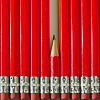Or search by topic
Number and algebra
Geometry and measure
Probability and statistics
Working mathematically
Advanced mathematics
For younger learners
Non-transitive Dice



Non-transitive Dice printable sheet
Here are three dice that are used to play a game for two players:

The red die has the numbers {1, 1, 6, 6, 8, 8}
The green die has the numbers {2, 2, 4, 4, 9, 9}
The blue die has the numbers {3, 3, 5, 5, 7, 7}
Each player chooses a different die.
They roll their dice.
The winner is the person whose die shows the bigger number.
Alison and Charlie are playing the game. Charlie wants to go first so Alison lets him.
Was that such a good idea?
Can you advise Alison on which die to choose once she knows which die Charlie has selected?
Dice of this sort are known as non-transitive dice. You can read more about transitivity in this article or have a go at creating your own in Dicey Dice. This spreadsheet might be useful if you want to create your own.
After you've had a go at the problem, you may be interested to read more about dice in the Plus articles Curious dice and Let 'em roll.
You may be familiar with another non-transitive game known as 'rock, paper, scissors'.
You may also like
Master Minding
Your partner chooses two beads and places them side by side behind a screen. What is the minimum number of guesses you would need to be sure of guessing the two beads and their positions?
Racing Odds
In a race the odds are: 2 to 1 against the rhinoceros winning and 3 to 2 against the hippopotamus winning. What are the odds against the elephant winning if the race is fair?


